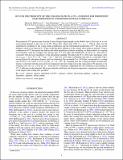| dc.contributor.author | Roediger, Joel | |
| dc.contributor.author | Veilleux, Sylvain | |
| dc.contributor.author | Ehlert, Steven | |
| dc.contributor.author | McDonald, Michael A. | |
| dc.date.accessioned | 2015-01-20T18:12:40Z | |
| dc.date.available | 2015-01-20T18:12:40Z | |
| dc.date.issued | 2014-08 | |
| dc.date.submitted | 2014-05 | |
| dc.identifier.issn | 2041-8213 | |
| dc.identifier.issn | 2041-8205 | |
| dc.identifier.uri | http://hdl.handle.net/1721.1/93074 | |
| dc.description.abstract | We present far-UV spectroscopy from the Cosmic Origins Spectrograph on the Hubble Space Telescope of a cool, star-forming filament in the core of A1795. These data, which span 1025 Å < λrest < 1700 Å, allow for the simultaneous modeling of the young stellar populations and the intermediate-temperature (10[superscript 5.5] K) gas in this filament, which is far removed (~30 kpc) from the direct influence of the central active galactic nucleus. Using a combination of UV absorption line indices and stellar population synthesis modeling, we find evidence for ongoing star formation, with the youngest stars having ages of 7.5 [+2.5 over -2.0] Myr and metallicities of 0.4 [+0.2 over -0.1] Z[subscript ☉]. The latter is consistent with the local metallicity of the intracluster medium. We detect the O vi λ1038 line, measuring a flux of f[subscript O VI, 1038] = 4.0 ± 0.9 × 10[superscript −17] erg s[superscript −1] cm[superscript −2]. The O vi λ1032 line is redshifted such that it is coincident with a strong Galactic H2 absorption feature, and is not detected. The measured O vi λ1038 flux corresponds to a cooling rate of 0.85 ± 0.2 (stat) ± 0.15 (sys) M[subscript ☉] yr[superscript −1] at ~10[superscript 5.5] K, assuming that the cooling proceeds isochorically, which is consistent with the classical X-ray luminosity-derived cooling rate in the same region. We measure a star formation rate of 0.11 ± 0.02 M[subscript ☉] yr[superscript −1] from the UV continuum, suggesting that star formation is proceeding at13 [+3 over -2]% efficiency in this filament. We propose that this inefficient star formation represents a significant contribution to the larger-scale cooling flow problem. | en_US |
| dc.description.sponsorship | United States. National Aeronautics and Space Administration (Space Telescope Science Institute (U.S.). Hubble Fellowship Grant) | en_US |
| dc.description.sponsorship | United States. National Aeronautics and Space Administration (Contract NAS5-26555) | en_US |
| dc.description.sponsorship | United States. National Aeronautics and Space Administration (Smithsonian Astrophysical Observatory. Subcontract SV2-82023) | en_US |
| dc.description.sponsorship | United States. National Aeronautics and Space Administration (Contract NAS8-03060) | en_US |
| dc.language.iso | en_US | |
| dc.publisher | IOP Publishing | en_US |
| dc.relation.isversionof | http://dx.doi.org/10.1088/2041-8205/791/2/l30 | en_US |
| dc.rights | Article is made available in accordance with the publisher's policy and may be subject to US copyright law. Please refer to the publisher's site for terms of use. | en_US |
| dc.source | American Astronomical Society | en_US |
| dc.title | HST-COS SPECTROSCOPY OF THE COOLING FLOW IN A1795—EVIDENCE FOR INEFFICIENT STAR FORMATION IN CONDENSING INTRACLUSTER GAS | en_US |
| dc.type | Article | en_US |
| dc.identifier.citation | McDonald, Michael, Joel Roediger, Sylvain Veilleux, and Steven Ehlert. “HST-COS Spectroscopy of the Cooling Flow in A1795—Evidence for Inefficient Star Formation in Condensing Intracluster Gas.” The Astrophysical Journal 791, no. 2 (August 6, 2014): L30. © 2014 The American Astronomical Society | en_US |
| dc.contributor.department | MIT Kavli Institute for Astrophysics and Space Research | en_US |
| dc.contributor.mitauthor | McDonald, Michael A. | en_US |
| dc.contributor.mitauthor | Ehlert, Steven | en_US |
| dc.relation.journal | Astrophysical Journal. Letters | en_US |
| dc.eprint.version | Final published version | en_US |
| dc.type.uri | http://purl.org/eprint/type/JournalArticle | en_US |
| eprint.status | http://purl.org/eprint/status/PeerReviewed | en_US |
| dspace.orderedauthors | McDonald, Michael; Roediger, Joel; Veilleux, Sylvain; Ehlert, Steven | en_US |
| mit.license | PUBLISHER_POLICY | en_US |
| mit.metadata.status | Complete | |
